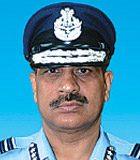INDIAN ARMED FORCES CHIEFS ON OUR RELENTLESS AND FOCUSED PUBLISHING EFFORTS

The insightful articles, inspiring narrations and analytical perspectives presented by the Editorial Team, establish an alluring connect with the reader. My compliments and best wishes to SP Guide Publications.

"Over the past 60 years, the growth of SP Guide Publications has mirrored the rising stature of Indian Navy. Its well-researched and informative magazines on Defence and Aerospace sector have served to shape an educated opinion of our military personnel, policy makers and the public alike. I wish SP's Publication team continued success, fair winds and following seas in all future endeavour!"

Since, its inception in 1964, SP Guide Publications has consistently demonstrated commitment to high-quality journalism in the aerospace and defence sectors, earning a well-deserved reputation as Asia's largest media house in this domain. I wish SP Guide Publications continued success in its pursuit of excellence.
Evolving 'UAV Swarm' Technology
Today the UAV technology is reasonably matured to enable UAVs of all sizes and types to successfully execute various types of military missions ranging from surveillance, electronic warfare, target designation to air-to-ground weapon delivery.
 |
The Author is Former Deputy Chief of the Air Staff and Air Officer Commanding-in-Chief, Central Air Command, IAF |
Hindustan Aeronautics Limited (HAL) has declared that it is working in partnership with New Space Research and Technologies, a Bengaluru based start-up, on a project todevelop air launched swarm of Unmanned Aerial Vehicles (UAV), which has been named as 'ALFA-S' an acronym for Air Launched Flexible Asset (Swarm).
Employment of UAV swarm in battlefield is an emerging technology, which has the ability to revolutionise warfare. UAV swarm technology for military applications is still at developmental stage and is expected to mature in near future.Large numbers of UAVs would be carried in containers to be released by an aircraft from high altitude for all of them to fly together in a swarm towards the objective area. With HAL's announcement, India has now joined select few countries that are independently developing UAV swarm technologies. The biggest advantage of UAV swarm is that it does notinvolve human lives and these UAVs come at a very low cost to be used as expendables.
Employment of UAV swarm in battlefield is an emerging technology, which has the ability to revolutionise warfare
UAVs with radar reflectors flying in large numbers ina swarm couldflood enemy's radars with very large numbers of targets to saturate enemy's air defence system, which in turn would exponentially enhance the survivability of manned strike aircraft formations. Similarly, UAV swarm equipped with electronic counter measures could degrade large number of sensors to suppress enemy's air defence system, which will severely reduce the enemy's ability to detect strike aircraft and interfere with them. UAV swarm equipped with sensors could carry out reconnaissance over large enemy territories and could be very useful in Combat Search And Rescue (CSAR) missions to recover downed pilots by enabling search capability coupled with ability to saturate and suppress enemy's air defence system. Depending on the size of the swarm, the UAVs could be programmed for single or a combination of tasks.
Large numbers of UAVs would be carried in containers to be released by an aircraft from high altitude for all of them to fly together in a swarm towards the objective area
The number of UAVs that can be containerised together for release by an aircraft is inversely proportion to the size of the UAVs. The effectiveness of the swarm lies in its numbers; therefore, micro UAVs are ideal to create aswarm because they can be easily carried in large numbers. Large UAVscan carry large payloads and even weapons for various military roles but it will be difficult to create a swarm of large UAVs. The small size of micro UAVsmakes it difficult for them to carry payloads and their size limits their capability to carry explosives in sufficient quantities to successfully attacks targets on ground, at best they could be effectiveonly against personnel in the open and to disrupt air defence systems like missiles and radars in the open. UAV swarms could also be programmed to interfere with enemy's communication networks.
UAVs in large numbers dispersed over enemy territories will provide significant capabilities towards reconnaissance, localising, degrading and suppressing enemy's air defences
Today the UAV technology is reasonably matured to enable UAVs of all sizes and types to successfully execute various types of military missions ranging from surveillance, electronic warfare, target designation to air-to-ground weapon delivery. The most challenging technology to operationalise UAV swarm will be the ability to control each UAV and coordinate them all towards the mission objective. All UAVs in the swarm will require a shared network amongst themselves and also with the airborne/ground based controlling agency. Artificial intelligence could be used to organise the UAVs within the swarm and enableautonomous decisions for each UAV based on information shared over the network.
Evolving UAV swarm technologies would have to find solutions to provide full authority towardsorganising and controlling all UAVs within the swarm, define communications standards for the swarm and the controlling agency to bring in interoperability to enable adding new UAVs to the swarm later over a period of time, develop miniaturised payloads to enable UAVs of small size to perform requisite military tasks and counter measures to prevent jamming or taking over of the swarm network.
UAVs in large numbers dispersed over enemy territories will provide significant capabilities towards reconnaissance, localising, degrading and suppressing enemy's air defences.UAV swarm will provide several military optionstowards enhancing national security and its potential needs to be fully exploited by developing the required supporting technologies.





